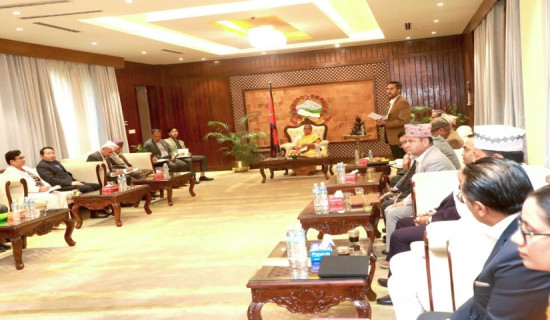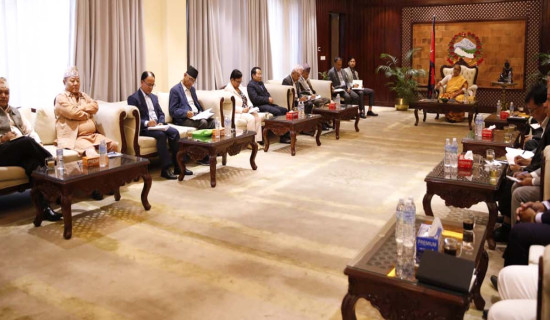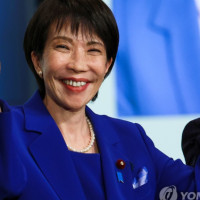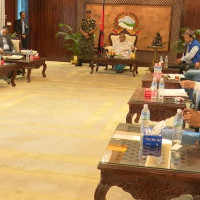- Tuesday, 21 October 2025
Women Empowerment Legacy Of Republic
After Bidya Devi Bhandari was appointed President of Nepal in 2015, a television journalist, Krishna Malla, asked me a question during an interview: “With a woman now leading the country, what significant change do you foresee for Nepali women?” Reflecting on the historic moment, I responded, "During our upbringing, we could never dream of being the head of a nation; it was beyond our imagination. Today, our daughters and granddaughters can imagine themselves becoming the head of the nation, unbound by any limitations."
Since the establishment of the democratic republic, various sectors have undergone substantial transformations. Although a comprehensive evaluation will offer a detailed overview, certain notable advancements in women's status have already been noticed. A key development is the implementation of a 33 per cent quota for women's representation in parliament. This equitable participation is observed consistently in the federal parliament, provincial assemblies, and local units.
Women as warriors
When studying different periods of the history of Nepal, it seems that the existence of women largely depended on men. During the Kirat, Lichchhavi, Malla, Shah, and Rana periods, as well as in the Baise Chaubise states, women played second fiddle to men. However, it does not appear that these eras created an environment for women to establish their own status. Queens and princesses greatly contributed to nation-building tasks in various ways. Historical documents show that the women, along with their male counterparts, fought tooth and nail against the British soldiers during the Nalapani battle (1814–1816). However, the names of these women have not been recorded.
Many women had revolted against their own families, society, the state, and even themselves. Examining history, from Nalapani Yuddha to the Maoist insurgency, reveals this fact. From the monarchy to the republic, women's struggle to ensure their participation and status has not been easy. The 1990 political change is considered significant for Nepali women in building their own status. However, there was not much change in women's participation in politics and other fields. Compared to the past, women's participation has increased in politics, civil service, media, law, and other sectors since the restoration of multiparty democracy.
Similarly, their role in the media also grew by leaps and bounds. Currently, 25 per cent of women are involved in the media sector. As the nation ushered in the republican set-up, women’s participation in politics increased qualitatively and quantitatively. In 2006, the Interim Parliament made historic announcements, bringing structural changes to the governance system. Several provisions were in favour of women's empowerment and growth.
The House of Representatives (HoR), which was restored following the 2006 people's uprising, declared a provision to ensure 33 per cent female participation in all state organs on May 30, 2006 (Jestha 16, 2063). Lawmaker Bidyadevi Bhandari proposed the parliamentary motion, which was seconded by Kamaladevi Pant and Narayan Prakash Saund (NP Saud). The proposal, registered as a matter of urgent public importance in the Parliament Secretariat, emphasised several key arrangements for women’s rights. Children could acquire citizenship under either the mother's or father's name, aligning with the goal of promoting equal participation. It underscored the necessity of ending violence against women and aimed to achieve equal citizenship status for women.
Enhanced status
The rationale for the discussion was explicitly stated as the imperative to secure equal status for women as citizens. Based on this motion, the Constituent Assembly Election Act guaranteed 33 per cent female participation in both Constituent Assembly elections. The essence of this commitment is reflected in the 2015 Constitution of Nepal, leading to the formulation of relevant laws or ongoing legislative processes. The achievement of 33 per cent participation in politics is very important. Additionally, the provision stipulating that one of the Speaker or Deputy Speaker positions will be held by a woman is also significant.
Female participation at the local level has reached 41 per cent, with 79 per cent of deputy mayors and vice chairpersons being women. The Local Election Act mandates that either the mayor or deputy mayor must be a woman, reflecting a growing trend of female involvement. There has been a substantial shift in women’s status, moving away from their identities being tied to their father, husband, or son. Women’s names, identities, positions, prestige, and self-esteem are on the rise. However, much remains to be done to achieve equal status in decision-making roles. It is essential to change perceptions and behaviours towards women, promoting their elevation from second-class citizens to equal citizens. This transformation is crucial to ensuring true equality in society.
(The author is a senior journalist.)




-square-thumb.jpg)











